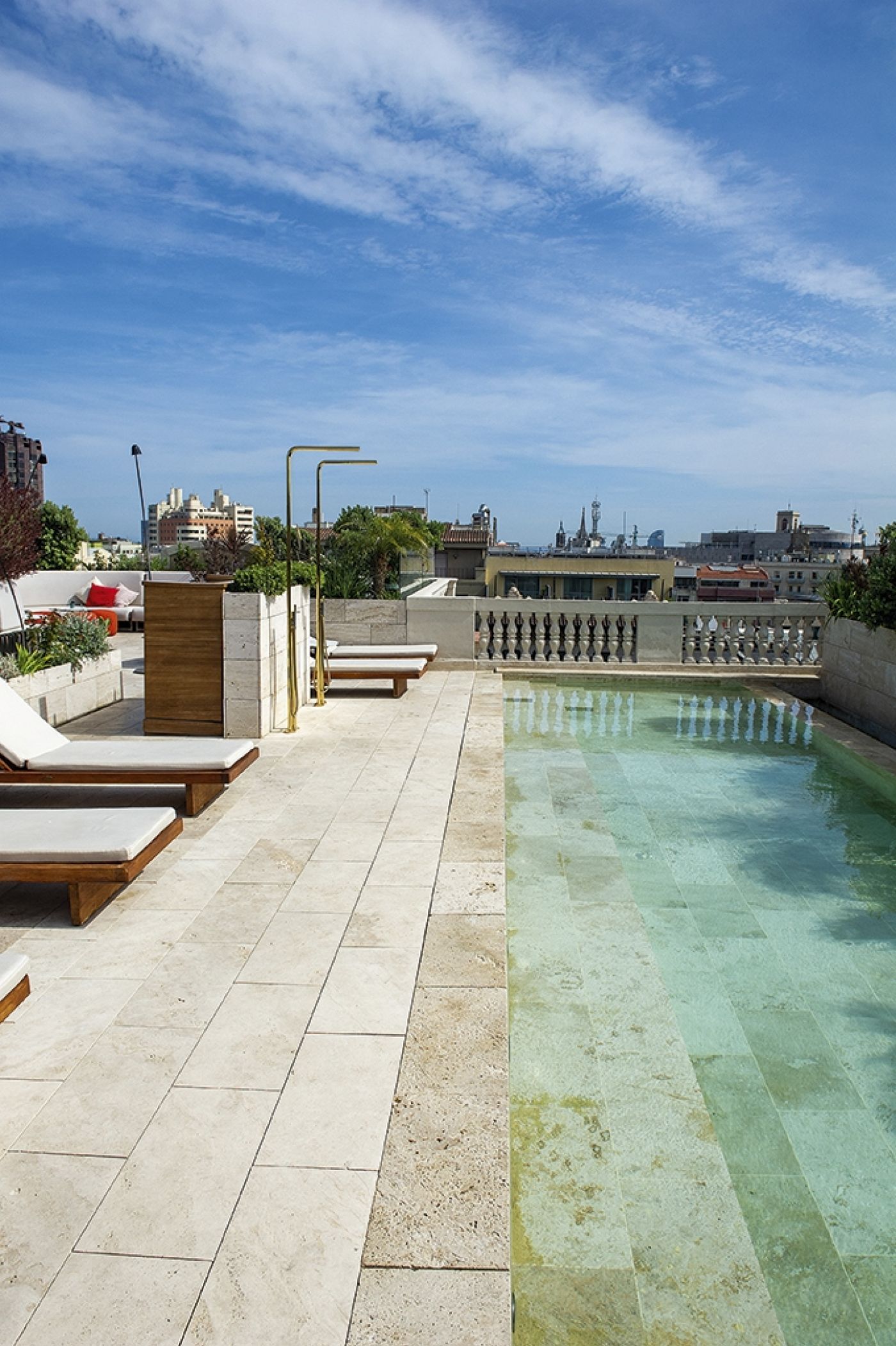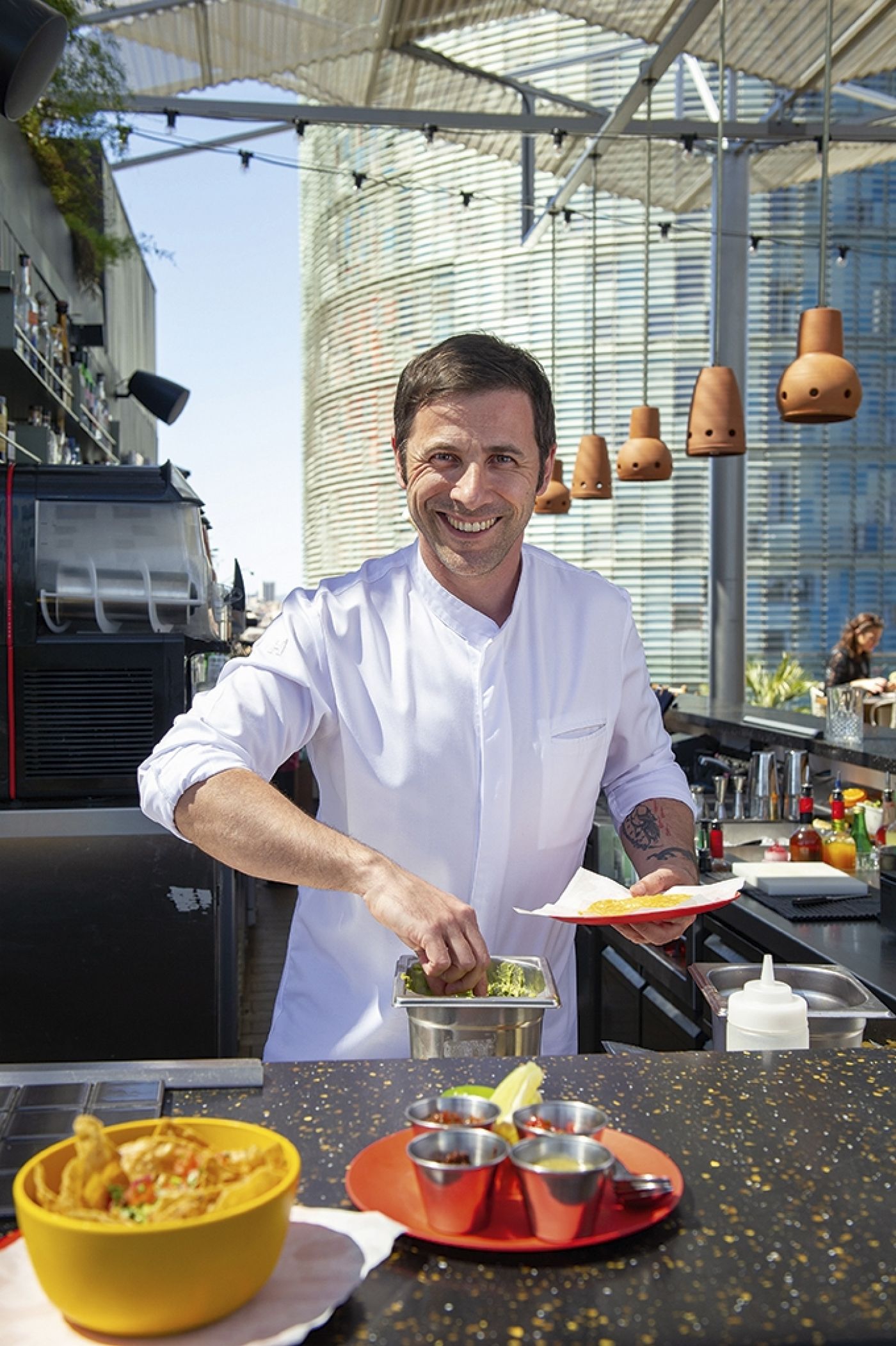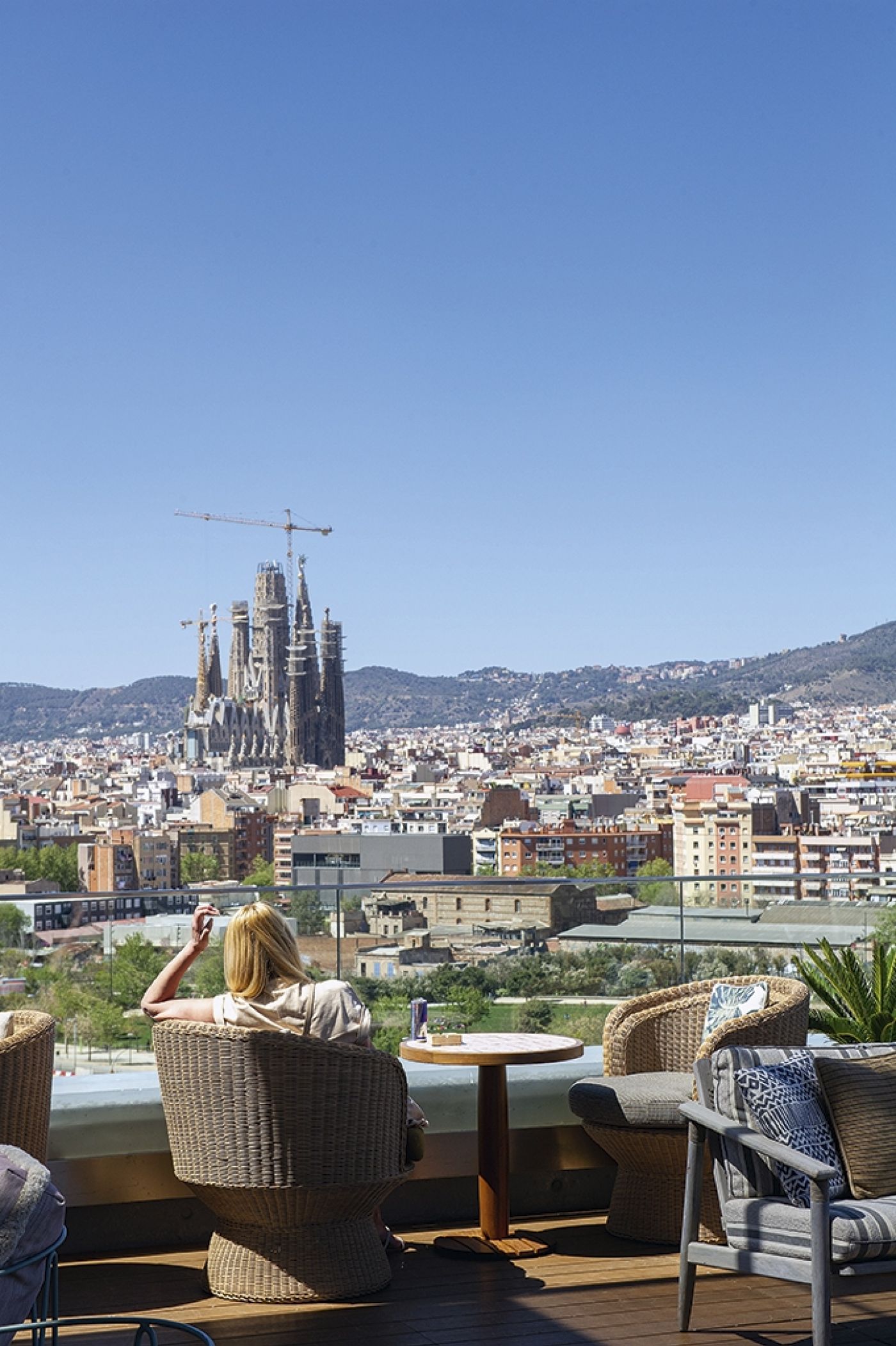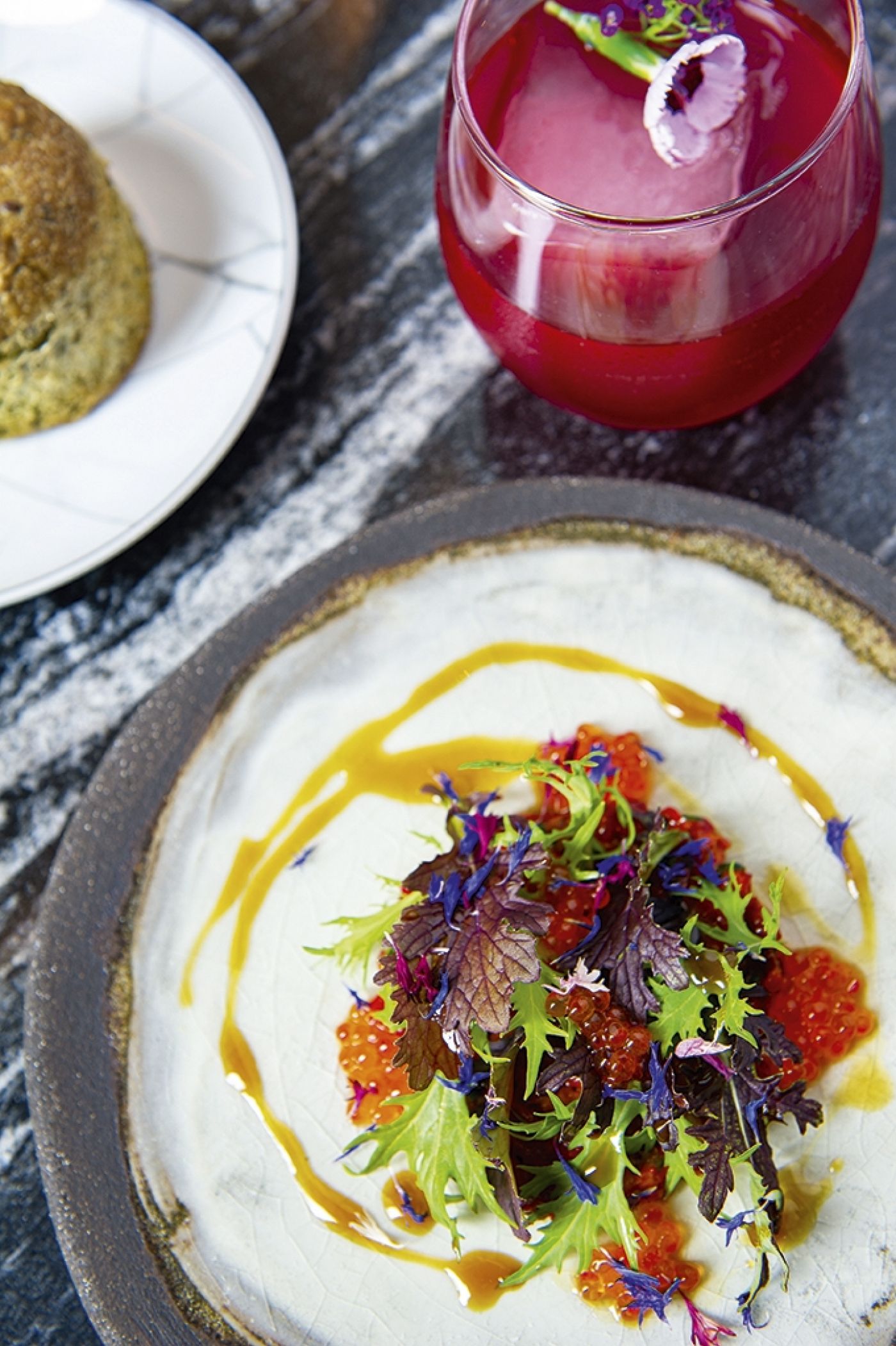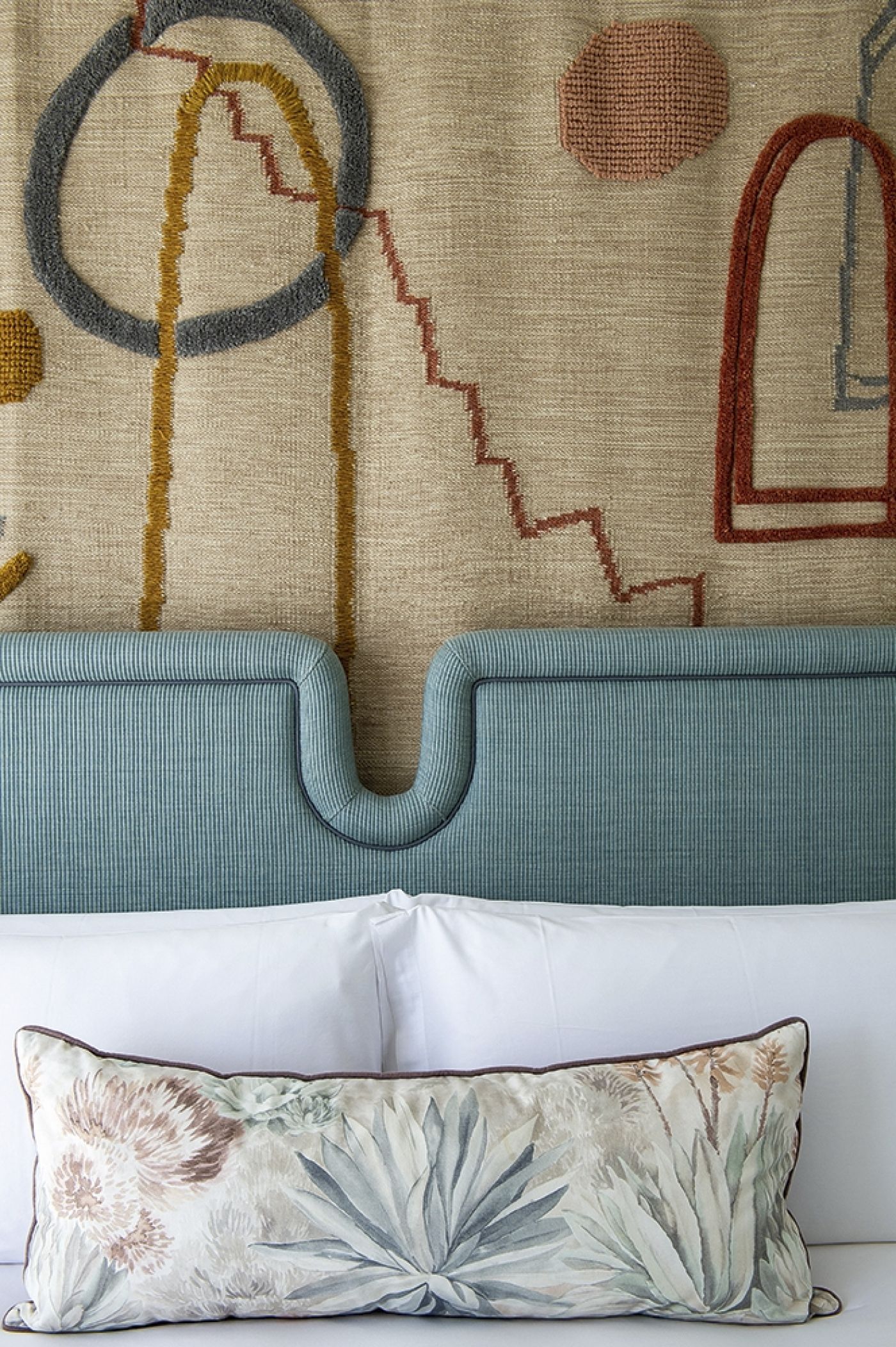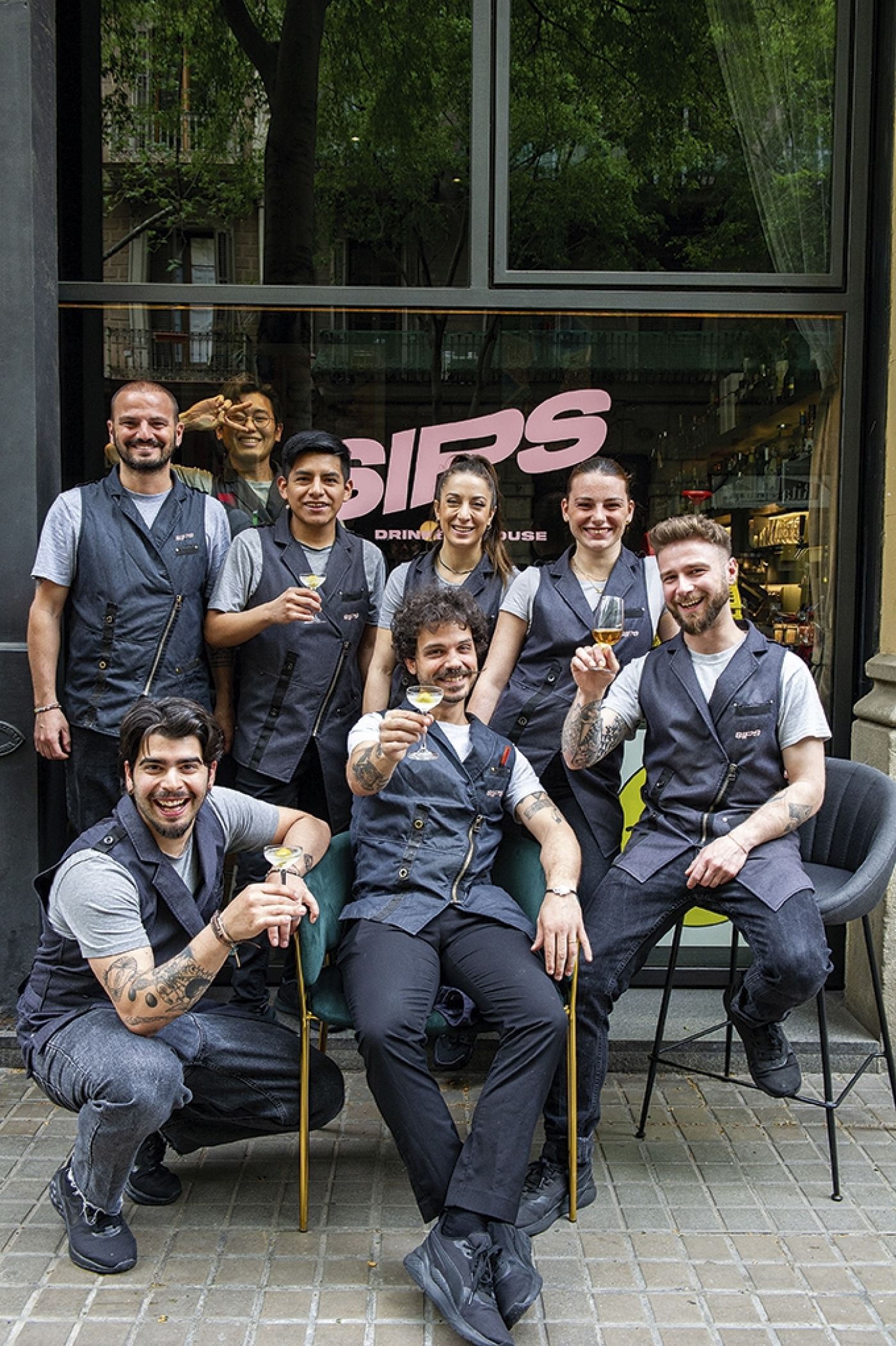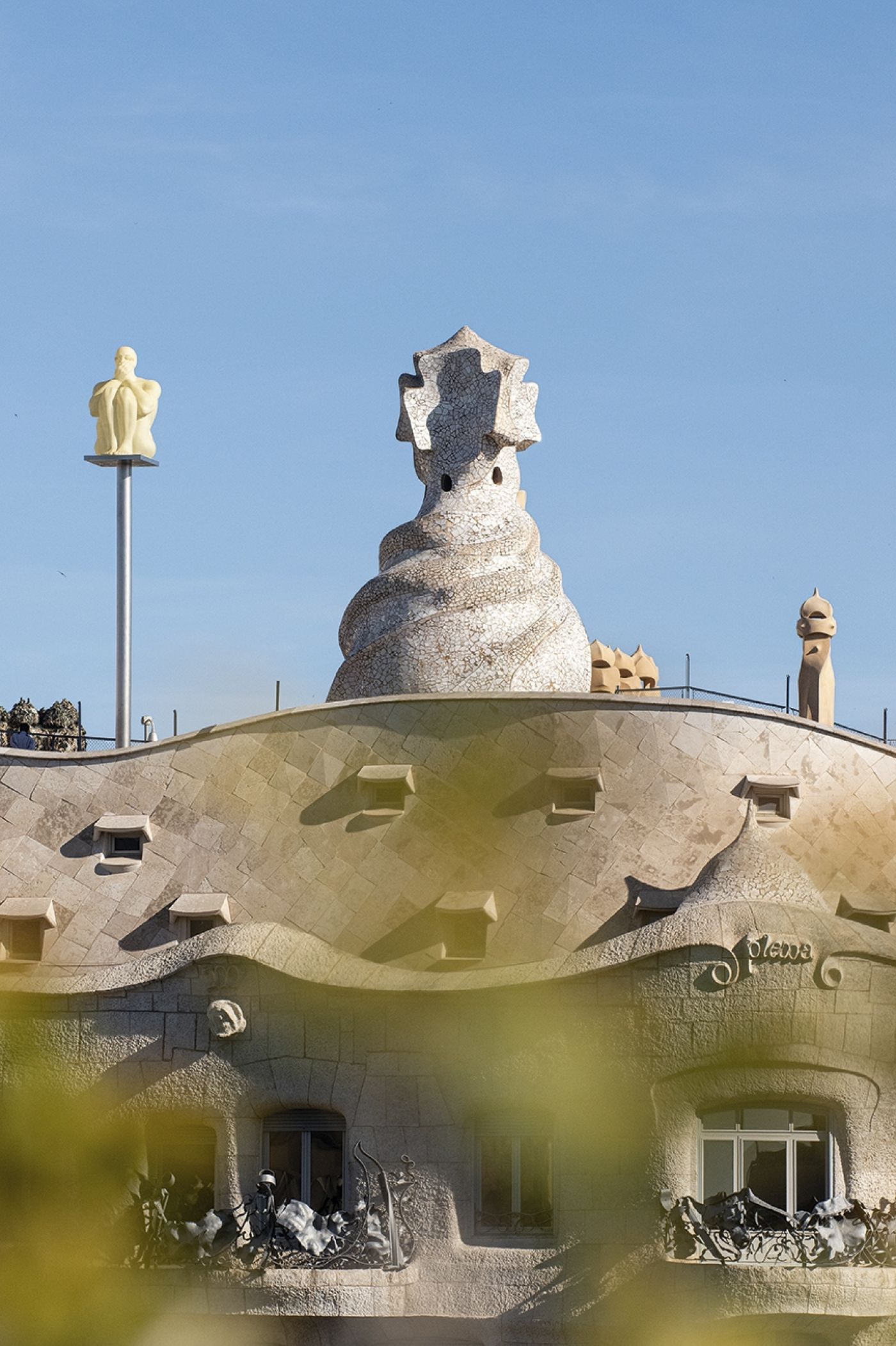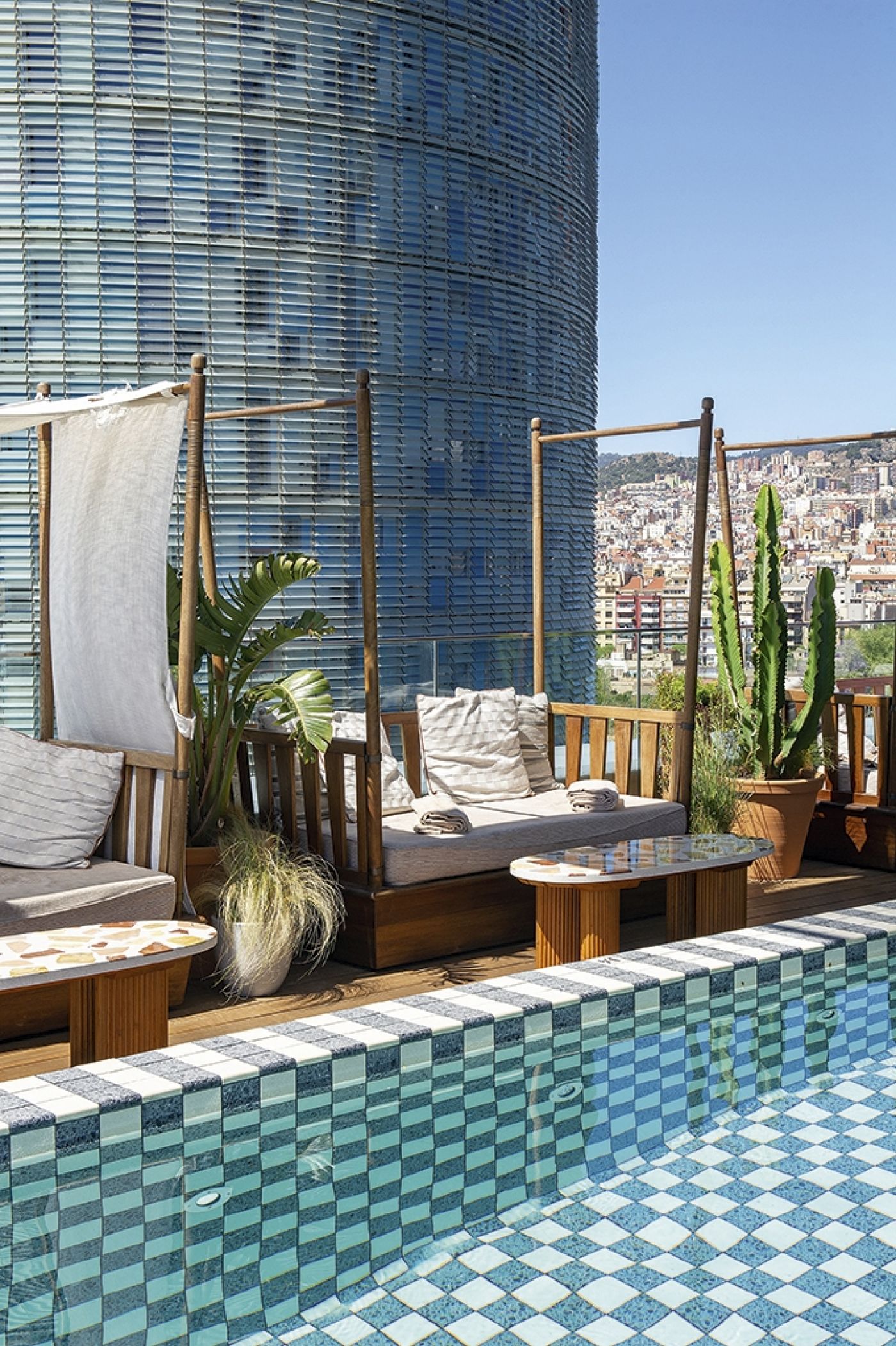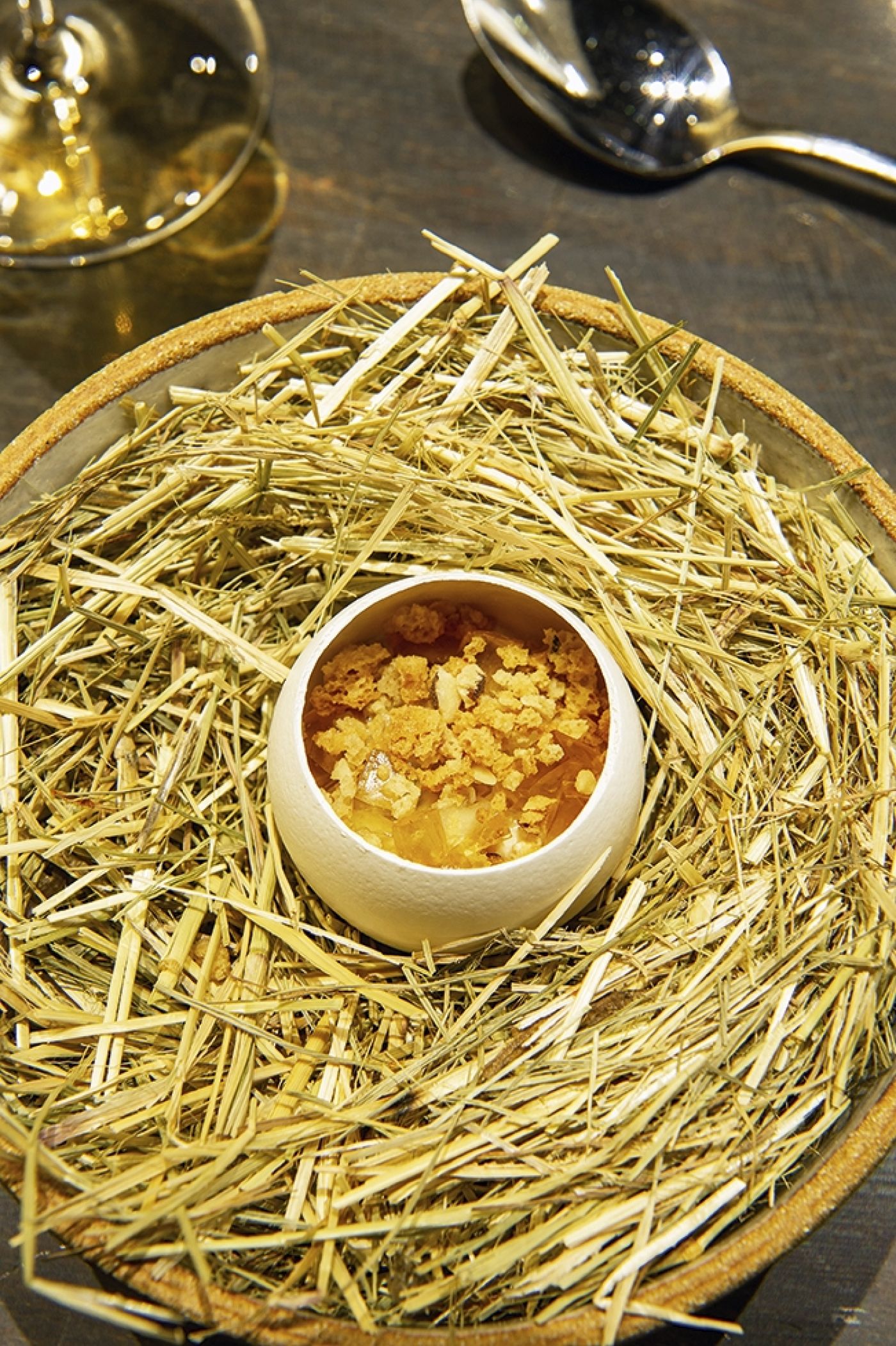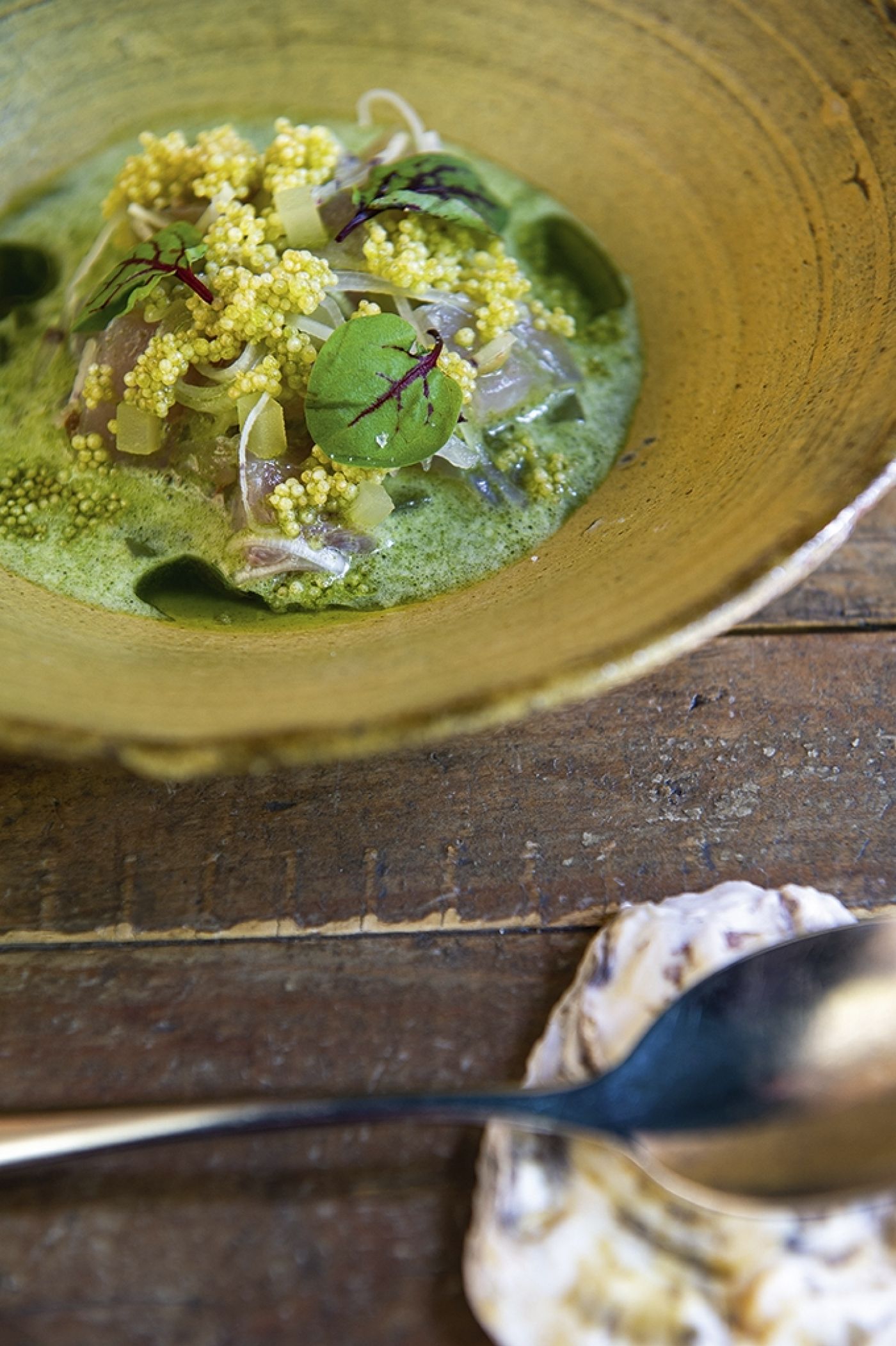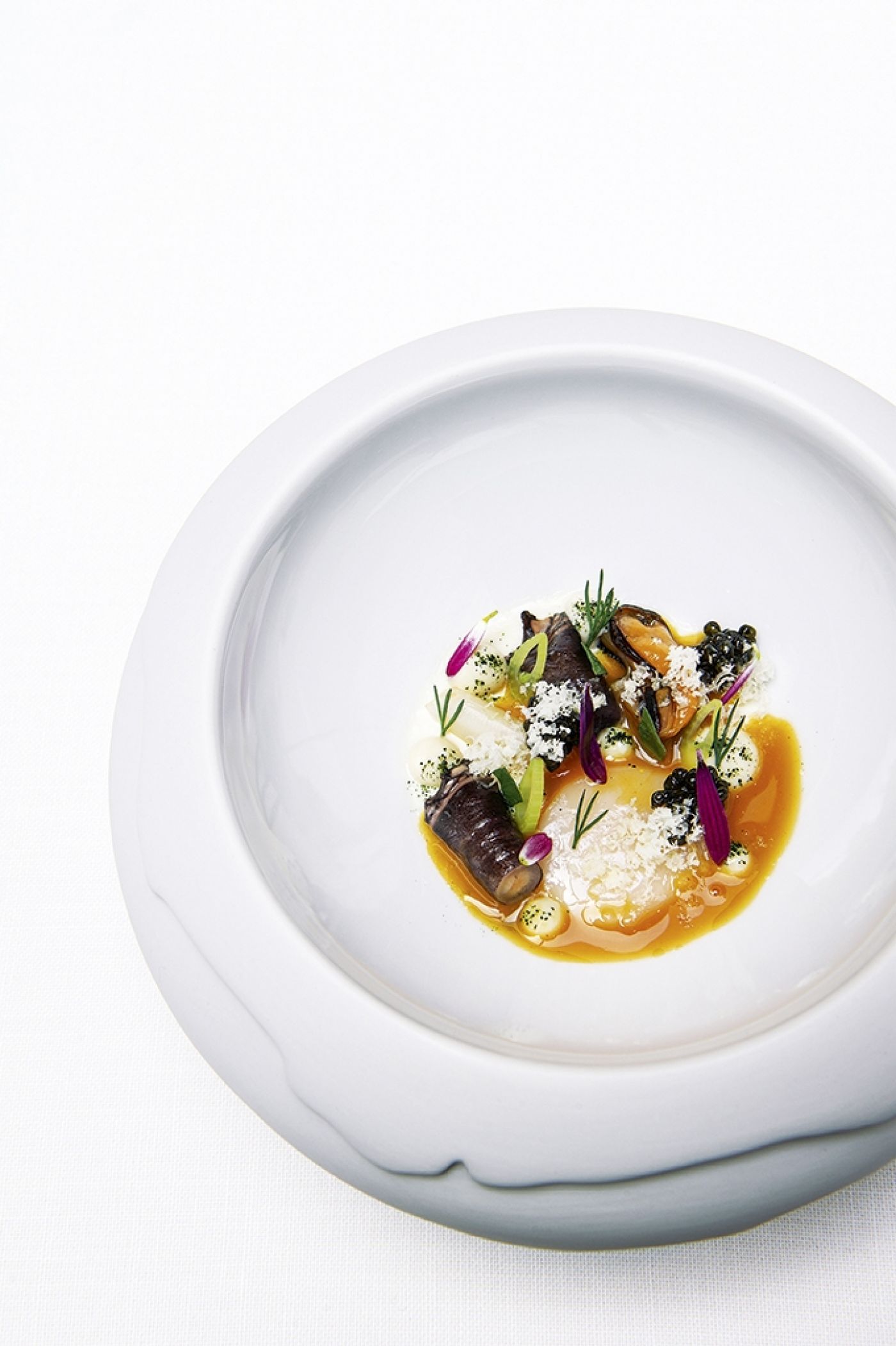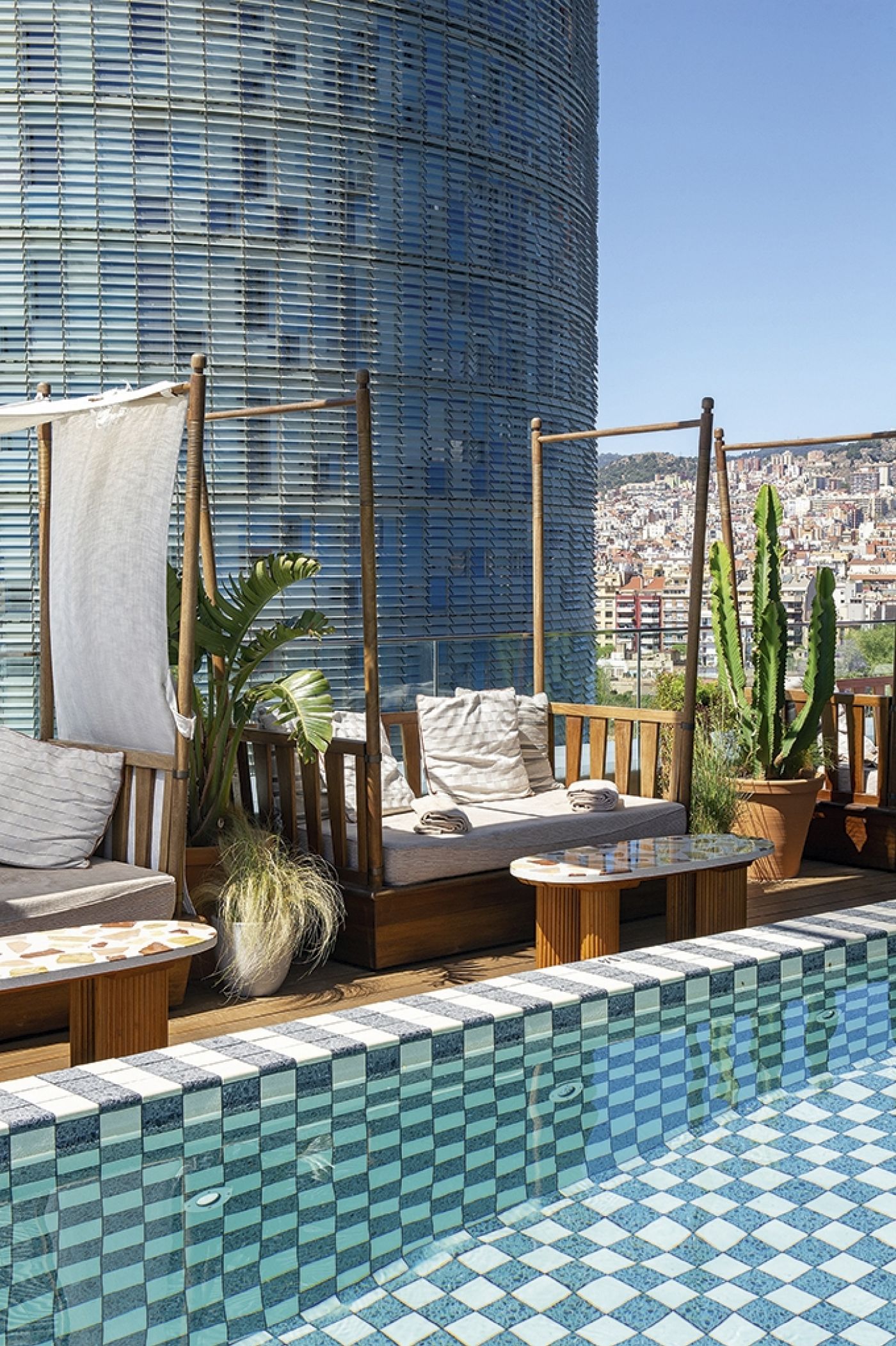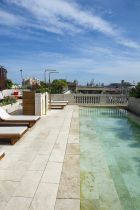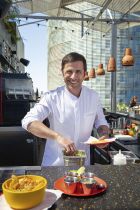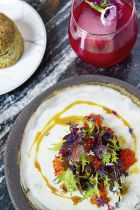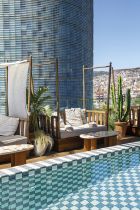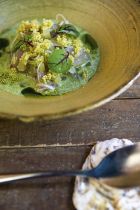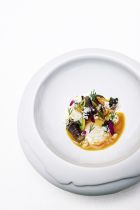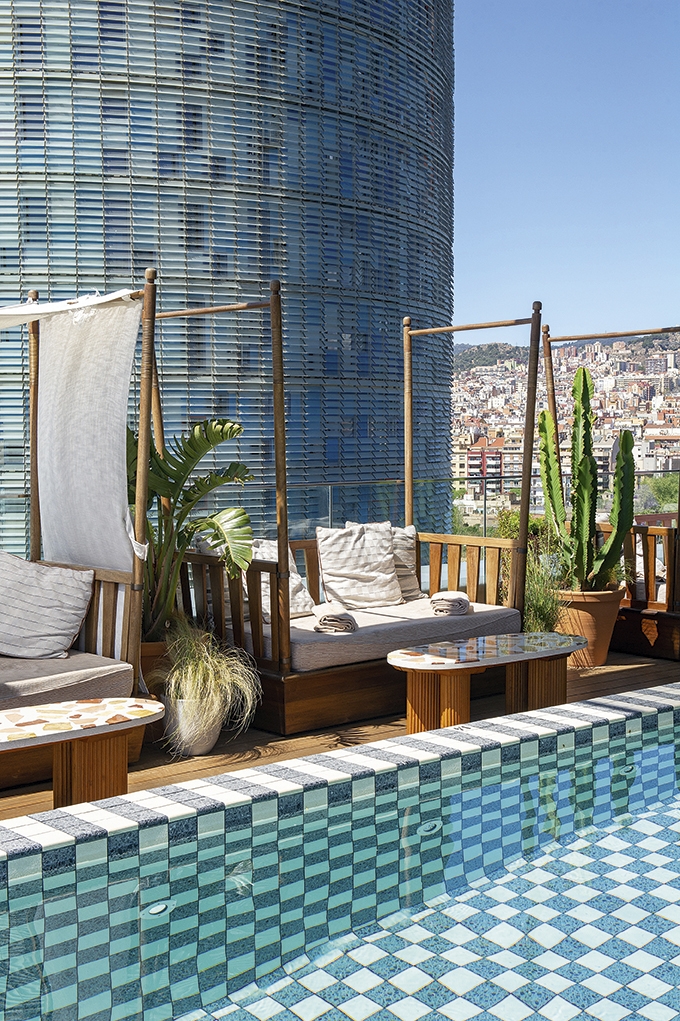
Food and Travel Review
Barcelona’s enduring appeal extends from out-there architecture to an idyllic coastal location, along with some of the world’s finest food, much of it concentrated in the Eixample neighbourhood. Words and photography by Marina Spironetti
Big cities are inevitably linked to stereotypes. Leaving the busy Plaça de Catalunya behind, your gaze wanders from the flower-shaped tiles of the pavements to the bow windows of the art nouveau apartment buildings – those images traditionally evoked
by the Catalan capital. Gaudì, of course. Year-round sunshine and urban beaches. Tapas. All very true, yet something of the bigger picture is missing.
The rich red shade of the Sant Antoni market hall gleams in the morning light. After almost a decade of renovation, traders have returned under its octagonal
dome, where everything is sparkling new. Essentially a very elegant community market, this is the place to look for anything from vegetables to charcuterie and
fresh meat. And a lot of fish. With the long Catalan coast being home to over 30 fishing ports, seafood is particularly abundant: sardines, red mullet, squid, cuttlefish, octopus, prawns, bream. Plus those coming from the chillier Atlantic waters, from bacallà (salted cod) to big-eyed, rose-red alfonsino.
The hustle and bustle of a market is always a great starting point to scratch the surface of a place. The fact that Barcelona has 39 and that you are never more than 10 minutes away from one says a lot about the Catalan approach to food. But a short walk beyond the busy artery of Gran Via, the 19th-century Eixample neighbourhood offers a deeper understanding of the creativity and talent at play here. The gridded ‘expansion district’ conceived as Barcelona started to spread beyond the maze of the Ciutat Vella has an unmatched concentration of fine-dining and Michelin-starred restaurants; it’s the perfect place to get to grips with the gastronomic buzz around a city that is firmly on the map of the world’s best food destinations.
Cinc Sentits sets the scene, with a name that promises a culinary experience capable of stimulating all five senses. The premise is good: Catalan-Canadian Jordi Artal taught himself how to cook following a marketing career in Silicon Valley and was awarded two Michelin stars for it. The journey starts in the low-lit antechamber, a modern, design-led version of the Torre de l’Espanyol landscape, where Jordi’s family produced olive oil and wine. Here, the apéritif is served on a bare wooden totem and sets out to recreate the flavours of the chef’s Catalan childhood: a rosemary-scented reconstructed olive, an anchovy on top of a ‘false rock’ of tomato sofrito and coca flatbread, and a smooth, icy vermouth, made from picapoll negre, an heirloom grape variety that has been resurrected.
The experience continues from the privileged perspective of the chef’s table, a front-row view of the kitchen at work, with Jordi inspecting every move of his dapper, flat-cap wearing staff with the elegance of a musical director. His cuisine has roots, and it comes
across clearly. Fragments of his life are delivered in each plate, in a kaleidoscope of textures and consistencies; the crispness of the white asparagus accompanied by a razor clam mayonnaise, the lusciousness of the turbot, perfectly cooked at 47C, hidden by the
most delicate mushroom carpaccio. And a warm Serradet cheese sphere enveloped in the most heart-warming Figueres onion consommé, inspired by his grandmother Sofia’s soup. Don’t be fooled, though. The flavour memory is his grandma’s, but the techniques are very modern and elaborate.
Techniques – right. In this city, terms like molecular gastronomy, deconstructivism and basic spherification are less obscure than anywhere else – and understandably so. Back in the Noughties, Ferran Adrià’s elBulli marked a paradigm shift in Western gastronomy, an earthquake whose shock waves are still being felt 12 years after its closure. It’s a legacy that has travelled way beyond the restaurant as some of those techniques are now regularly used around the world, even by home cooks.
‘ElBulli lives on in different ways – it opened new paths. Lots of chefs worked there for a very long time and now they all have their own projects,’ explains Nil Dulcet, partner and director of Compartir Barcelona. Opened just over a year ago, this is the third restaurant of former elBulli trio Casañas, Castro and Xatruch – after a first, Compartir, in the coastal town of Cadaqués and then Disfrutar in Barcelona (which took third place on The World’s 50 Best Restaurant 2022 list).
Nil has been part of the team since the times of the elBulli mothership. With Compartir, he stays away from the avant-garde path of sister restaurant Disfrutar, however.
‘It’s cocina de producto, as opposed to Disfrutar’s cocina de creatividad,’ he points out, leading the way into a dining room where curved mirrors and wicker dividers aim to create a contemporary, urban interpretation of the town of Cadaqués.
A certain joyfulness accompanies the meal from beginning to end, with plates that are made to be shared (hence the name compartir, ‘to share’) and are an explosion of flavours. Nil’s version of a thin, crisp, red pizza served on a colour-coordinated tile sets the mood; the deep, earthy taste of oregano combined with the sweetness of tomatoes is the start of a ride. And one with a lot of fun, from cold flamed mackerel with a reconstructed black olive that pops mischievously in your mouth to the unmissable canelón, a raw tuna sashimi rolled up like cannelloni and filled with tuna tartare. A triumph of different consistencies surrounded by saturated splodges of olive, tomato and basil.
The splendid Passeig de Gràcia is only two blocks down, with its modernist extravaganza and exclusive shops. Everything is grand here, from the ornate lampposts to the smallest fragments of ceramics embedded into the benches. Here, opposite the flowing shapes of Gaudì’s La Pedrera, the Monument Hotel hosts a veritable temple of gastronomy, with four Michelin stars between two restaurants: three at Lasarte and one at next-door Oria. All under the gastronomic direction of Basque Martín Berasategui, Spain’s most star-studded chef.
Lasarte became Barcelona’s first three-starred restaurant back in 2017, when Italian chef Paolo Casagrande took the lead as chef de cuisine, adding his own touch to the exquisite dishes first conceived by his master. ‘The stars aligned, quite literally!’ he shrugs with genuine modesty. His secret? Living in the creative turmoil of a place like Barcelona.
‘This city is constantly pushing its limits; we are always faced with the pressure of a constant evolution in all fields – architecture, music, medicine. And gastronomy, of course. There is a continuous wave of innovation, a mix of different cultures and a striving to do better that sets the bar higher every time – which means great restaurants and even greater results. It’s incredibly stimulating,’ he explains.
Paolo’s cuisine is nothing less than a perfectly composed symphony. His calamari tartare is something you’ll remember for a very long time – the magic encounter between the thickness of egg and the soft, chewy consistency of the mollusc, with the added delicacy of a sweet onion consommé. The warm seafood salad is another unforgettable dish, with sea urchin, prawns and glasswort bringing the depths of the sea to your plate.
Mixing elements of different culinary traditions is at the core of Paolo’s philosophy. ‘That’s the beauty of juggling between three cuisines – Basque, Catalan and Italian – on a technical and conceptual level,’ he says. ‘And then there’s the produce we have – great meats, fish and vegetables. Catalonia is the perfect ecosystem for great gastronomy.’
Trace your steps back along Carrer de Mallorca, and you’ll be struck by the enormous variety that can be packed into a single neighbourhood. For all that you taste – and learn about the area – there’s the feeling you’ve barely scratched the surface. For instance, a turn off into Carrer d’Aribau takes you to the dark green awning outside seafood gastro restaurant Besta Barcelona: it’s one to watch, yet the small, unpretentious entrance makes it go almost unnoticed.
It all began quite adventurously in 2020, in the midst of the pandemic, when Carles Ramón (a Catalan who lived in Galicia) and Manu Núñez (a Galician who moved to Barcelona) joined forces, combining their respective cuisines and the finest in-season produce from both regions.
‘It started as something small and simple, with just the two of us in the kitchen,’ recalls Carles as he pours a generous glass of Cava. 'Two years on, we are 13.’ And in the meantime Manu has moved to their newly opened bistro on the Gran Via.
Besta (Galician for ‘animal’) lives up to its name. Its radical, uncompromised approach makes it a different beast indeed. ‘Besta-style is always something fresh. We work with a lot of acidities – with citrus, vinegar, fermentations, and plenty of herbs,’ explains Carles. ‘Many of our dishes are green, which is the colour that represents our cuisine the most.’
It’s easy to see what he means as soon as you take your first bite of his alfonsino fish, which he combined with the tanginess of sorrel leaf juice and the irresistible piquancy of nasturtium root, achieving an incredible freshness. Your only regret, perhaps, might be that it’s a bit like a Paganini piece – most likely, you won’t be able to taste it again on your next visit. The menu changes weekly and they avoid giving the dishes names; instead, each plate is a mere description of its main ingredients.
‘We always add our own touch,’ says Carles. ‘My ceviche, for example, might be quite different from the idea other people have of it. This is why we’d rather avoid definitions and leave you free to describe it according to what it is to you.’
Equally, signature dishes are banned. ‘When something becomes signature, I replace it immediately. The way I cook is the way I feel. Sometimes it’s more extreme, sometimes it’s simpler. I do whatever I want,’ he says, grinning, before disappearing theatrically behind the thick velvet curtains that separates the kitchen from the restaurant. The end of another magical performance.
Yet another indication that the essence of this city’s culinary scene can’t be crystallised into something definite. The key to their excellence is a constant evolution, like those cranes dotting the horizon, and a continuous movement, like the waves of the sea. Pushing one’s limits, going beyond.
Where to stay
Almanac Barcelona All 91 high-tech rooms come with extra-comfortable custom-made beds and hyper-modern marble bathrooms – book into a signature Almanac room for a window seat overlooking Gran Via. The view broadens further on the eighth floor at the Azimuth rooftop bar, where cocktails and a secluded pool make it a favourite spot for guests and locals alike. Doubles from £326. A special Foodie Package including bespoke gourmet tour of the city, half-day out to the Torelló vineyards (see Don’t Miss) and a tasting menu at plant-forward Virens restaurant, costs from £1,750 for a two-night stay for two. Gran Via de les Corts Catalanes 619-621, 00 34 930 187000, almanachotels.com/barcelona
Hotel Arts Barcelona Spectacularly housed in one of the two 154m towers overlooking the Port Olímpic, this address is all about luxury. The higher the floor, the swankier the facilities – rooms from the 30th to the 33rd floor can use a dedicated Club Lounge with gourmet buffets and drinks served throughout the day, and penthouse suites come with a personal butler service. A rooftop spa, two outdoor swimming pools, an art gallery and unrivalled views make it hard to leave, especially with top-notch food and drink options including two-Michelin-starred Enoteca Paco Pérez, P41 Bar serving signature drinks from along the 41st parallel, and brand-new restaurant The Pantry, with an emphasis on Catalan and Spanish produce. Impeccable yet affable service is the icing on the cake. Doubles from £540. C/ Marina 19-21, 00 34 932 211000, hotelartsbarcelona.com
The Hoxton, Poblenou The first Spanish outpost of The Hoxton group, just opposite Torre Glòries in the heart of hip Poblenou district, is as trendy as its neighbourhood. Its 240 rooms offer a retro take on Mediterranean style – think woven tapestries, terracotta flooring and zellige-tiled bathrooms, with attention paid to the smallest of details such as ‘Coffee now, Cava later’ mugs. The view sprawls from Jean Nouvel’s cigar-shaped tower to the visionary spires of Gaudí’s Sagrada Família, and is best enjoyed with a poolside margarita on the rooftop. Doubles from £261. Avinguda Diagonal 205, 00 34 932 717222, thehoxton.com/poblenou
Monument Hotel This 19th-century neo-gothic palace turned modern hotel on the elegant Passeig de Gràcia, opposite Gaudí’s La Pedrera, opened in 2019. It’s part of the Preferred Hotels group, which represents some of the best independent hotels in the world, so don’t expect anything short of excellence. Rooms feature exposed bricks, leather couches and hardwood flooring, plus wrought iron balconies with original mosaic tiles. Martín Berasategui, the chef with the most Michelin stars in the country, signs the menus of both Oria and Lasarte restaurants – with four stars between the two of them, there’s plenty to keep gourmet travellers happy. Should that not be enough, his delicious gastronomic proposals can also be sampled on the first and third Sunday of the month when Yummy Sundays brunch is served on the splendid Verbena rooftop terrace. Doubles from £330. Passeig de Gràcia 75, 00 34 935 482000, monumenthotel.com
Travel Information
Sitting on Spain’s eastern coast, Barcelona is the capital of Catalonia. The region has two official languages: Spanish and Catalan, and many residents are bilingual. Time is one hour ahead of GMT and currency is the Euro. Flights to Barcelona-El Prat Airport, around 35 minutes from the city centre, depart daily from major UK airports. Flight time is around 2 hours.
GETTING THERE
easyJet fly from London Gatwick and Manchester to Barcelona. easyjet.com
British Airways have several daily flights from London Heathrow and Gatwick airports. britishairways.com
GETTING AROUND
Hola Barcelona Travel Card offers unlimited travel on the metro, bus, tram and train, from two to five days. From £14pp. tmb.cat
RESOURCES
Barcelona Turisme offer a practical guide for your stay, with information on things to do and what to visit. barcelonaturisme.com
Turespaña The National Tourist Office can help you plan your trip to the wider area and regions across the country. spain.info/en
Where to eat
Prices are per person for a three-course meal, excluding drinks, unless otherwise stated
Aguaribay In the heart of trendy Poblenou district, a five-minute walk from the beach, this informal and cosy restaurant has become a veggie classic since it opened in 2010. The cuisine of Argentinian-Italian duo Valentina Monge and Francesca Pinna fuses their respective culinary heritages with local organic produce. Dishes are unpretentious and colourful – try their seasonal risotto de la casa with Ebro Delta organic rice or their version of South Indian dosa, a thin crêpe made with a fermented batter of lentils and
rice. Wash it all down with a glass of natural wine or one of their delicious juices. From £25. C/ del Taulat 95, 00 34 933 003790, aguaribay-bcn.com
Besta Barcelona This gastro seafood restaurant blends the finest produce from both regions of its Catalan and Galician owners. Get in the mood with their in-house gin infused with oysters from the bar at the entrance. The market-inspired menu changes weekly, according to seasonal ingredients and the chefs’ mood, allowing for maximum creative freedom in the kitchen. Each dish is a little masterpiece, combining skills and techniques with a pinch of rebellion that is already labelled as ‘Besta-style’. From
£32.50. C/ d’Aribau 106, 00 34 930 198294, bestabarcelona.com
Cinc Sentits As the name suggests, a meal here will awaken all five senses spectacularly. There is a sixth one, though – and that’s memory. Two-Michelin-starred Chef Jordi Artal takes you by the hand through his Catalan childhood for a unique culinary journey. Dishes and bites are accompanied by small explanatory cards that will tell you more about the ingredients and inspiration behind each one; think Costa Brava prawns, Figueres sweet onions, lobsters from Galicia and Catalan unfermented fresh Mató cheese. Farmers and artisans make much of the menu. They are even featured in the little booklet that you will be given at the end of your meal, plus a map showing where each ingredient was sourced, reflecting the love behind this venture. Tasting menu with around 13 ‘moments’ £136. C/ d’Entença 60, 00 34 933 239490, cincsentits.com
Compartir Barcelona The elBulli alumni behind this recently opened restaurant are the same team behind Compartir in the coastal town of Cadaqués and legendary Disfrutar in Barcelona. Nothing to do with the molecular path of the latter, though. Chef Nil Dulcet’s cuisine is joyful, colourful and full of saturated flavours, with food served on platters and
meant for sharing. Start with a selection of cold and hot oysters before moving on to mains – make sure you try their signature tuna cannelloni and the unmissable panchino, a filled brioche with soured cream and caviar, a light and tasty classic from Disfrutar. Desserts are worth a special mention too, from an inventive sweet caprese to the scrumptious hazelnut refresher with apricot sorbet. From £34.30. C/ de València 225,
00 34 936 247886, compartirbarcelona.com
Enoteca Paco Pérez Impeccable is the word to describe everything in the bright-white dining room of two-Michelin-starred Enoteca, from pristine tablecloths to staff in white gloves. Chef Paco Pérez’s love of mar i muntanya (Catalan for surf ’n’ turf) features in many of his dishes and expresses itself at its best in an apparently unorthodox blend like crab and mushrooms. ‘The sea remembering Gaudì’ is evocative and flowing, like the art it honours: flavours are circular, like a wave, and take you to the depths of the sea in a
symphony of sea urchin, red tuna, prawn and caviar, all rigorously raw. The wine cellar here is one of the most extensive in the city (enoteca translates as ‘wine shop’), so expect to be inspired by recommendations such as sherry to accompany savoury dishes. From £128. Carrer de la Marina 19-21, 00 34 934 838108, enotecapacoperez.com
Lasarte Barcelona’s first three-starred restaurant is brought to you by Martín Berasategui, the chef who holds the most Michelin stars in Spain. The kitchen is under the lead of Italian chef Paolo Casagrande, who puts his own touch on the exquisite creations of his San Sebastián maestro. Start with squid tartare with egg yolk, onion and kaffir consommé, perhaps, followed by crustacean ravioli and iodised sauce, topped by the most delicate foam of rosé champagne. Round things off with pastry chef Xavi Donnay’s cinnamon spheres, tangerine and roses – as beautiful as a jewel. From
£144. C/ de Mallorca 259, 00 34 934 453242, restaurantlasarte.com
Tope This spot on the rooftop of The Hoxton, Poblenou is much more than a buzzy taqueria. Chef Marcos Sierra, who has worked at the likes of Michelinstarred restaurants such as Lasarte (see above) and Taberna de Lillas Pastia in Huesca, delivers ‘the essence of the Mediterranean in a Mexican way’. Expect punchy Mexican tacos and tostadas made with local produce, with other highlights including vegan ceviche with tiger’s milk and mushrooms, a fusion of Mexican and Peruvian. Poolside cabanas and one of the best views in town will have you lingering long after lunch pondering the long list of cocktails. Tacos, £10.30. Avinguda Diagonal 205, 00 34 932 717660, topetacos.com/barcelona
Virens Keeping it light, healthy and plant-forward, Michelin-starred Rodrigo de la Calle (who holds one red and one green star at his Madrid restaurant El Invernadero) has come to Barcelona putting greens front and centre. The son of farmers, he has devoted most of his career to the investigation of superfoods and fermented beverages. Here, he invites us to step out of our culinary comfort zone to rediscover mushrooms and little-known vegetables, with organic meats and fish on the side. Homemade drinks include mead and elderberry kombucha. From £47. Gran Via de les Corts Catalanes 619-621, 00 34 930 187451, virensbarcelona.com
Food Glossary
- Ajoblanco
- A chilled, white, almond and garlic soup that is a classic served in every home in Spain
- Allioli
- A rich garlic and olive oil sauce. Originally meant to accompany cod, it also pairs well with starchy vegetables, meats, salads and eggs
- Bunyols
- Traditional deep-fried fritters. Bunyols de bacallà, with dried salt cod, are a popular savoury variation. A staple at tapas bars, they are usually accompanied with dipping sauces such as allioli
- Calçot
- A type of white, elongated onion, milder and less bulbous than regular varieties. Those from Valls, near Tarragona, have a PGI status. The most traditional ways of eating them is at a calçotada, a celebration held between November and April, where barbecued onions are consumed in massive quantities, often with romesco sauce
- Coca bread
- Traditional Catalan flatbread. It comes in many different variations, both sweet and savoury, and with a variety of toppings
- Orxata
- The Catalan name for horchata, a summer drink originally from the Valencian Community, made by blending soaked tiger nuts (chufas), water and sugar. It often includes cinnamon and sometimes lemon zest
- Mató
- An unfermented fresh cheese produced in the Catalan territories, typically served as a dessert with honey (known as mel i mató)
- Pa amb tomàquet
- Toasted bread sprinkled with salt, rubbed with tomatoes and drizzled with olive oil. A Catalan classic
- Romesco
- A sauce from the Tarragona area consisting of tomatoes, red peppers, onions and a variety of roasted or raw nuts. Being extremely versatile, it is the perfect accompaniment to many dishes from fish to vegetables. It is also consumed as a dipping sauce for grilled calçots
- Xarel-lo
- A Spanish grape variety best known for its use in Cava. It is also used for medium-bodied dry white wines, with good acidity. Xarel-lo wines pair well with fish and oysters and make an excellent apéritif
Get Premium access to all the latest content online
Subscribe and view full print editions online... Subscribe

